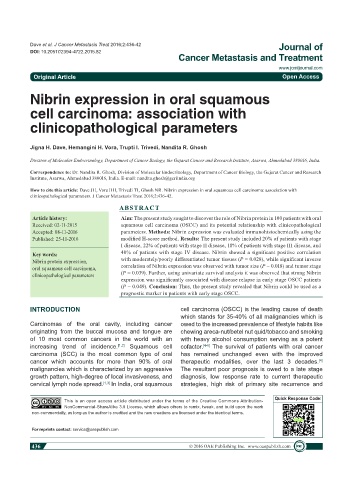Page 446 - Read Online
P. 446
Dave et al. J Cancer Metastasis Treat 2016;2:436-42 Journal of
DOI: 10.20517/2394-4722.2015.82
Cancer Metastasis and Treatment
www.jcmtjournal.com
Original Article Open Access
Nibrin expression in oral squamous
cell carcinoma: association with
clinicopathological parameters
Jigna H. Dave, Hemangini H. Vora, Trupti I. Trivedi, Nandita R. Ghosh
Division of Molecular Endocrinology, Department of Cancer Biology, the Gujarat Cancer and Research Institute, Asarwa, Ahmedabad 380016, India.
Correspondence to: Dr. Nandita R. Ghosh, Division of Molecular Endocrinology, Department of Cancer Biology, the Gujarat Cancer and Research
Institute, Asarwa, Ahmedabad 380016, India. E-mail: nandita.ghosh@gcriindia.org
How to cite this article: Dave JH, Vora HH, Trivedi TI, Ghosh NR. Nibrin expression in oral squamous cell carcinoma: association with
clinicopathological parameters. J Cancer Metastasis Treat 2016;2:436-42.
ABSTRACT
Article history: Aim: The present study sought to discover the role of Nibrin protein in 100 patients with oral
Received: 02-11-2015 squamous cell carcinoma (OSCC) and its potential relationship with clinicopathological
Accepted: 08-11-2016 parameters. Methods: Nibrin expression was evaluated immunohistochemically using the
Published: 25-11-2016 modified H-score method. Results: The present study included 20% of patients with stage
I disease, 22% of patients with stage II disease, 18% of patients with stage III disease, and
Key words: 40% of patients with stage IV disease. Nibrin showed a significant positive correlation
Nibrin protein expression, with moderately/poorly differentiated tumor tissues (P = 0.028), while significant inverse
oral squamous cell carcinoma, correlation of Nibrin expression was observed with tumor size (P = 0.018) and tumor stage
clinicopathological parameters (P = 0.039). Further, using univariate survival analysis it was observed that strong Nibrin
expression was significantly associated with disease relapse in early stage OSCC patients
(P = 0.049). Conclusion: Thus, the present study revealed that Nibrin could be used as a
prognostic marker in patients with early stage OSCC.
INTRODUCTION cell carcinoma (OSCC) is the leading cause of death
which stands for 35-40% of all malignancies which is
Carcinomas of the oral cavity, including cancer owed to the increased prevalence of lifestyle habits like
originating from the buccal mucosa and tongue are chewing areca-nut/betel nut quid/tobacco and smoking
of 10 most common cancers in the world with an with heavy alcohol consumption serving as a potent
increasing trend of incidence. [1,2] Squamous cell cofactor. [4-6] The survival of patients with oral cancer
carcinoma (SCC) is the most common type of oral has remained unchanged even with the improved
cancer which accounts for more than 90% of oral therapeutic modalities, over the last 3 decades.
[4]
malignancies which is characterized by an aggressive The resultant poor prognosis is owed to a late stage
growth pattern, high-degree of local invasiveness, and diagnosis, low response rate to current therapeutic
cervical lymph node spread. [1,3] In India, oral squamous strategies, high risk of primary site recurrence and
Quick Response Code:
This is an open access article distributed under the terms of the Creative Commons Attribution-
NonCommercial-ShareAlike 3.0 License, which allows others to remix, tweak, and build upon the work
non-commercially, as long as the author is credited and the new creations are licensed under the identical terms.
For reprints contact: service@oaepublish.com
436 © 2016 OAE Publishing Inc. www.oaepublish.com

